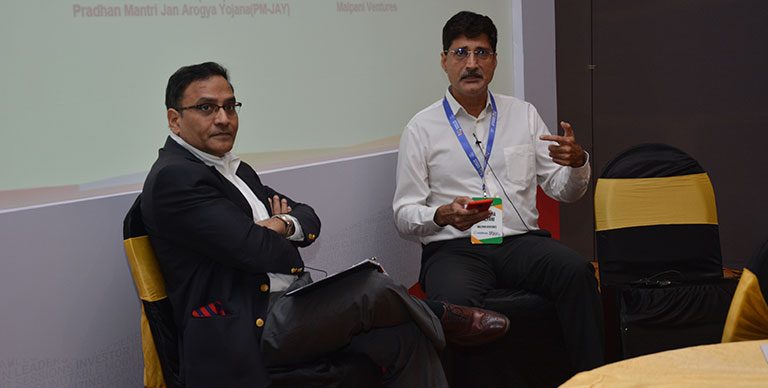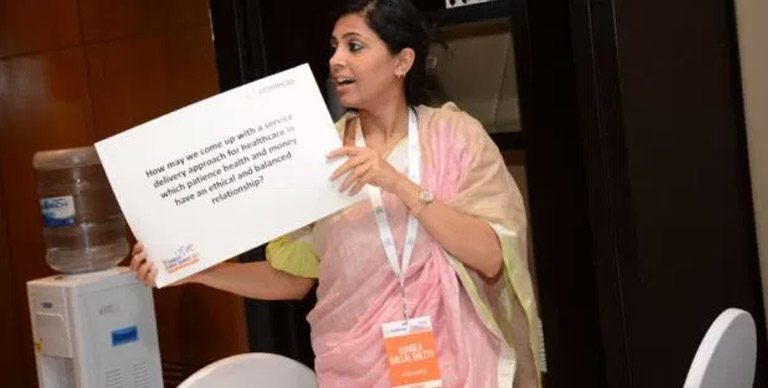India in 2050: Future of Food
Food wars triggered by scarcity and price of food are likely by 2050 unless we change how food is produced, processed, and supplied
Most major wars fought in the last two centuries have been focused on control of precious resources like minerals, oil, and land. This picture has started to shift in the past few years, with armed conflict increasingly focused on control over depleting water resources and by association food. Climate change-linked droughts in Northern Africa and Sahel, and the resulting shortage of food is one of the triggers behind the European refugee crisis. As these populations relocate to other areas, competition for scarce resources intensifies and results in conflict against the “others” – as we have seen in Western Europe. This is by no means an isolated trend, but the beginning of a pattern we can expect to see in India as well. By 2050, the India’s population will reach 1.7 billion people, creating the most populated country in the world. Food demand will increase by 70%, and is already lagging domestic food production.
Growing prosperity coupled with changes in food patterns will mean that much of this demand will be for water intensive food commodities such as meat. Output of animal products has already overtaken cereals, and accounts for one-third of all agricultural output. Eventually we will reach a tipping point when the demand for meat can no longer be met without shifting agricultural land towards cultivation for cattle, or importing meat. Unfortunately, growing prosperity will walk hand-in-hand with growing inequity – leaving those who live on less than $5 a day unable to afford high-protein diets with requisite micronutrients. If agriculture and food production continues its “business as usual trajectory”, low income and vulnerable communities will likely only be able to access carbohydrates as staple foods. We are already seeing the impact of carbohydrate-rich foods on these communities in terms of higher prevalence of chronic diseases such as diabetes and hypertension. As diets worsen the prevalence of these diseases will continue to increase, resulting in a vicious cycle which wipes out economic prosperity gains because of increased healthcare expenditure, and in-turn curtails spend on healthier food options. Solutions of the past decade such as high quality inputs and farm mechanization will start to prove insufficient in our quest to feed more and more people healthy diets at affordable prices.
Disruption is imminent in the next decade across value chains and commodities; the future is likely to be one of abundance rather than scarcity
So does this mean the future is bleak? We think not. Human history is a story of triumphs of ingenuity in how food is grown, processed, and distributed. From shifting cultivation, to fixed and specialized farming, to the industrial revolution, and finally the green revolution in India – every few generations we see a leap in technologies that pivot eras of scarcity into eras of abundance. The next pivot is coming, and it is unlike anything we have ever seen before. As exponential technologies such as IoT, machine learning, and robotics commercialize and converge; we will see fundamental shifts in terms of where food is grown, what food is grown, who grows it, and what we expect from it.
WHERE FOOD IS GROWN: Farms of the future will be decentralized, and located in currently unused resources such as oceans and building sides and rooftops
Traditional models of horizontal land farms will soon reach their peaks of efficiency in India despite high quality inputs and mechanization. The growing demand for meat and protein-based food will be a key driver behind this. Further, as population growth continues, farmlands will compete with more economically lucrative uses of land – for industries, housing, and cattle rearing. So what will be do when we run out of arable land? The answer to this problem will likely be found in 3 ways. First, cultivation will increasingly move to the sea. India has a coastline of 7,517 kilometers, which could potentially provide arable surface area of 15 million hectares on the surface of seawater. But experiments have shown that it is possible to grow food crops to a depth of 5 to 8 meters, indicating potential to grow food in layers – and potentially increase the arable surface area by 4-5x. However, given maritime trade considerations and weather, only a portion of this potential can be unlocked. So other alternate resources are required to grow food. The second avenue will be vertical urban farming – growing food on rooftops and sides of massive multistory buildings that dominate city skyscapes in major metros. It is estimated that a city such as Mumbai with a population of 12.5 million could produce enough food for itself by building an infrastructure of 100 vertical farm towers of 30 storeys each. The third land-like resource unlocked for farming will be individual homes. Kitchen gardens are by no means a new concept in India – in fact the authors of this article recall that while growing up, most of the vegetables consumed at home were also grown at home. With growing urbanization, space for these gardens has disappeared, as has the time to look after them. IoT-enabled, fully automated, and self-contained kitchen garden devices can solve this challenge. And as prices of staples such as onions skyrocket every year – market forces are ripe for commercial-scale adoption of these devices. We expect that by 2030-2040s, urban and home-level farming will be the primary source of fresh food – decreasing the need to package, store, and transport food over large distances – and hence decreasing the overall carbon footprint of farming.
WHAT FOOD IS GROWN: Food sources will shift from resource-intensive and slow-growing plants and animals to resource-efficient and rapidly growing microbes
To truly pivot from a future of scarcity to a future of abundance – shifts are needed in what we consider to be a food source. Plants and animals will be replaced by microbes, manipulated and processed into food that imitates plant and animal foodstuffs in flavor and texture, but without being as resource intensive and slow-growing. In fact, this shift is already happening as parts of the developed world adopt meat-like alternates to replace meat. These are grown using plant proteins and algae in industrial and laboratory settings, and taste so much like the originals that consumers cannot tell them apart from real meat and eggs. As the technology is perfected, it is easy to imagine microbes being used as the starting material for any number of foods – from rajma-chawal to butter chicken-naan. In fact, coupled with artificial intelligence like IBM Watson Chef and 3-d food printers, microbes could result in a Star Trek-inspired food replicator by 2050. The affordability and economies of scale possible with microbes could also mean that high-quality and tasty food may be truly democratized for all. In fact, with our changing and largely sedentary lifestyles, many Indians no longer require as many calories per day as we once did. Given this, and the growing trend towards maintaining healthy Body Mass Indices, meal-replacement products such as Soylent could find widespread adoption and further decrease demand for food, as we know it today.
WHO GROWS THE FOOD: Deskilling of food production and processing will once again distribute responsibility for farming across communities
One of the greatest tragedies of modern-day India is the lot dealt out to our farmers. 55% of Indians are employed in agriculture but they create a net contribute of only 16% to the GDP – primarily because most of these farmers are engaged in subsistence agriculture. For the farmers who grow crops for market, value chain inefficiencies and lack of market linkages means that farming is always a net-loss activity – farms invest more effort and cash than they are able to get back by sales of produce. As a result, the number of people engaged in agriculture is declining year-on-year; and will ultimately result in an unbalanced system where a small minority grows food for a large majority. We believe by 2050, this picture will change quite drastically. In the short-term technology and democratization of information will help to upskill farmers and help them grow based on markets needs and climate trends. However in the medium-to-long term, large scale agriculture on land, oceans, and vertical urban farms will become highly mechanized and supervised by technical talent. On the other side of this spectrum, communities and homes will take more accountability for growing their own fresh food.
WHAT WE EXPECT FROM FOOD: Personalized health and wellness outcomes will be increasingly expected from food in addition to nutrition
As we progress from scarcity towards abundance, food will become a basic human right in India much like water and air are. The debate around food inequity will shift from a calorific or micronutrient debate to a quality and function debate. With a shift from plant and animal-sourced nutrients to microbe-sourced nutrients, extreme transparency on the nature of food will become a standard expectation from consumers much like food calorie profiles are today. This is important given that the allergen profile of microbes is only beginning to be understood. For instance, Soylent had to recall of several batches of its products last year after some customers started to fall ill after consuming them. Food transparency has even more complex connotations in India – especially given cultural norms around vegetarianism. While most vegetarians consume microbes with food such as yoghurt, many may not be aware of the exact composition. There are likely to be questions raised about the faith-based ethics as well as regulatory challenges of classifying foods made of microbes as vegetarian or non-vegetarian.
While on one hand, consumers will expect harm from food to be completely eliminated; on the other hand it might also be possible for food to create positive impact beyond just nutrition. Consider this – Indians living in most urban centers face ubiquitous exposure to risk factors such as air pollution which trigger chronic diseases like diabetes, cardiovascular diseases, and cancers. But what if this ubiquitous exposure to disease triggers could be combated with ubiquitous exposure to risk mitigations through food? After-all most non-communicable diseases develop through metabolic pathways, and could potentially be combated at a deeply personalized level. Imagine that an individual at risk of breast cancer from genetic as well as environmental triggers is able to manage it by simply asking her artificial intelligence-powered food replicator to grow microbial foods that shift her metabolic pathways. In fact, in a truly connected world, her healthcare provider may simply prescribe code that is fed into her kitchen computing system automatically, with always-on body sensors detecting minute changes and continuously reprogramming how food is being grown.
The future of food is coming, but will it be inclusive?
While it might seem like many of these technologies are too far-fetched and futuristic to be true, it is important to remember that the pace of technological advancement we’re currently witnessing is unprecedented. 50 years back, Apollo 11 put the first man on moon using its era’s most advanced computer navigation system. Today, the phone you’re probably reading this on can navigate up to 120,000,000 Apollo 11 rockets simultaneously. The question for those of us working in inclusive development is not whether the future of food will be disrupted by technology. It is how can we ensure that this disruption results in equitable access to good quality food for all, regardless of how much they earn or where they live. To do this, those at the forefront of food innovation must be exposed to real-world problems of the 3 billion low-income and underserved people in emerging markets. The onus is on those of us working to bridge the gap between the private sector and development goals.
Authors:
Nisha Dutt is Chief Executive Officer of Intellecap, a Global Firm building entrepreneurial ecosystem focused on South Asia, South East Asia and Africa. She serves on boards of listed companies. Her career spans across 15 years of experience in strategy and operations in national and multinational corporates.
Dipika Prasad is setting-up the Intellecap Innovation Labs; a new initiative focused on leveraging exponential technologies to solve challenges faced by low-income communities in emerging markets. She has spent the past 7 years conceptualizing, testing, and scaling social entrepreneurship and innovation models across South Asia and East Africa.








